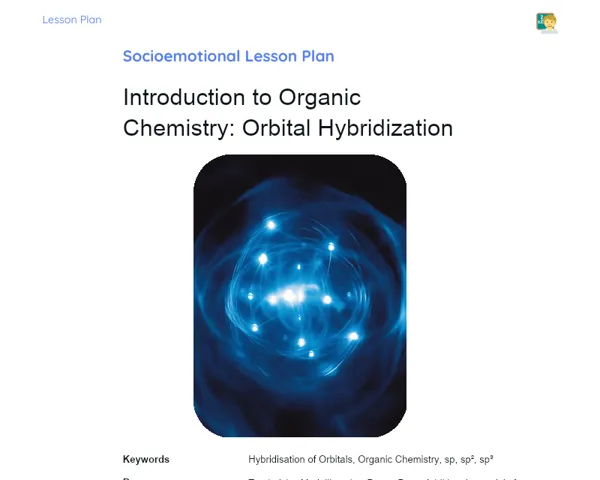Lesson Plan | Lesson Plan Tradisional | Organic Functions: Ester Nomenclature
| Keywords | Esters, IUPAC Nomenclature, Organic Compounds, Carboxylic Acids, Alkyl Group, Fragrances, Artificial Flavours, Organic Chemistry, Structural Difference, Practical Applications |
| Resources | Whiteboard, Markers, Eraser, Multimedia Projector, Presentation Slides, Printed Worksheet, Pens, Notebooks for notes |
Objectives
Duration: (10 - 15 minutes)
The aim of this stage is to give students a clear and straightforward understanding of what they need to learn during the lesson. By laying out the expectations for what they should grasp by the end, students can focus their attention and efforts more effectively. This builds a solid foundation for future learning and ensures everyone is on the same page regarding the lesson objectives.
Objectives Utama:
1. Name and recognise esters accurately using IUPAC nomenclature.
2. Tell apart ester nomenclature from that of other organic compounds.
Introduction
Duration: (10 - 15 minutes)
This stage aims to pique students' interest and frame the significance of the topic. By connecting the content to real-life examples and intriguing facts, a stronger, more relatable bond is formed, aiding in the retention of information. This introduction also paves the way for a more detailed approach that follows, ensuring that students are engaged and ready to dive into the intricacies of ester nomenclature.
Did you know?
Did you know that esters are behind many of the natural scents and flavours we love? For instance, the smell of a green apple or the taste of pineapple comes from different esters. Moreover, many esters are utilised in the food industry to create artificial flavours, like the strawberry taste in sweets and chewing gum. This shows how organic chemistry is closely tied to our everyday lives, even influencing what we eat and the scents we enjoy.
Contextualization
To kick off the lesson on ester nomenclature, start by discussing the role of organic compounds in chemistry and your everyday life. Explain that esters are a functional group found in various products we encounter daily, like perfumes, flavourings, and even medications. Emphasise that organic chemistry is critical for developing new materials and compounds that provide various benefits to society. By grasping ester nomenclature, students will learn to recognise and differentiate these compounds from others, which will be essential for exams and future practical applications, particularly for those interested in sciences or engineering careers.
Concepts
Duration: (30 - 40 minutes)
This stage focuses on providing detailed explanations of the nomenclature of esters, making sure students comprehend the IUPAC naming rules and can apply them to identify and name different esters. Additionally, solving practical problems will reinforce their learning and build their confidence.
Relevant Topics
1. Definition of Esters: Explain that esters are organic compounds made from carboxylic acids, where the hydrogen of the carboxyl group gets swapped out for an alkyl or aryl group. The general formula for esters is R-COO-R'.
2. IUPAC Nomenclature of Esters: Share that esters follow a naming system where the alkyl group (R') attached to the oxygen comes first, followed by the name of the relevant carboxylic acid, with 'ate' replacing the usual ending. For example, the ester created from acetic acid and ethanol is called ethyl acetate.
3. Examples of Nomenclature: Provide various examples like methyl formate (H-COO-CH3), ethyl propanoate (CH3-CH2-COO-CH2-CH3), and methyl butanoate (CH3-CH2-CH2-COO-CH3). Break down each, showing the structure and explaining how to name them.
4. Difference between Esters and Other Organic Compounds: Illustrate how to tell esters apart from other organic compounds, such as alcohols, carboxylic acids, and ethers. Highlight distinct structural features and naming conventions for each functional group.
5. Applications of Esters: Briefly discuss how esters are used in everyday life, from fragrances to artificial flavours and medications. Explain how the chemistry of esters is essential in various industries that produce everyday products.
To Reinforce Learning
1. What is the name of the ester that comes from butanoic acid and methanol?
2. What are the structural differences between an ester and an ether?
3. For the compound CH3-CH2-COO-CH2-CH3, what is its correct IUPAC name?
Feedback
Duration: (20 - 30 minutes)
This stage is about reinforcing students' understanding of ester nomenclature through a thorough discussion of the questions posed. Engaging students in questions and reflections will deepen their comprehension, encouraging critical thinking and practical application of their acquired knowledge.
Diskusi Concepts
1. 📚 Question 1: What is the name of the ester from butanoic acid and methanol?
To name the ester, first identify the alkyl group linked to the oxygen, which in this case is methanol, making it ‘methyl’. The carboxylic acid is butanoic acid, which we convert to ‘butanoate’ by replacing 'ic' with 'ate'. So, the ester is methyl butanoate.
2. 📚 Question 2: How do you differentiate the structure of an ester from that of an ether?
Esters have the general formula R-COO-R', with a carbonyl group (C=O) attached to an oxygen that’s also linked to an alkyl or aryl group. Ethers have the formula R-O-R', where an oxygen connects two alkyl or aryl groups, without a carbonyl group. The key difference is the presence of the carbonyl group in esters.
3. 📚 Question 3: For the compound CH3-CH2-COO-CH2-CH3, provide its correct IUPAC name.
To name this ester, start by identifying the alkyl group linked to the oxygen, which is the ethyl group (CH2-CH3). The corresponding carboxylic acid is propanoic acid (CH3-CH2-COOH). Change the ending ‘ic’ to ‘ate’, so we get ‘propanoate’. Hence, the ester is ethyl propanoate.
Engaging Students
1. 💡 Question 1: Why is it essential to distinguish esters from other organic compounds in organic chemistry? 2. 💡 Question 2: How might knowing ester nomenclature be useful in real-life situations, such as in identifying scents or flavours? 3. 💡 Question 3: Can you think of a product you use that might contain esters? What ester is in that product and what does it do? 4. 💡 Reflection: How can understanding ester nomenclature assist you in your future studies or career?
Conclusion
Duration: (10 - 15 minutes)
This stage aims to reinforce learning by recapping the essential points covered in the lesson and stressing the importance and practical applications of the content. This solidifies knowledge and illustrates the relevance of the topic to daily life and future academic or professional paths.
Summary
['Definition of esters as compounds derived from carboxylic acids.', 'Rules for IUPAC nomenclature of esters, including how to identify the alkyl group and the relevant acid.', 'Detailed examples of ester nomenclature, such as methyl formate and ethyl propanoate.', 'Structural and nomenclatural differences between esters and other compounds like alcohols, carboxylic acids, and ethers.', 'Practical uses of esters in fragrances, artificial flavours, and medications.']
Connection
The lesson linked theory to practice by providing clear examples of how to name esters and discussing their real-world applications. Students could see the relevance of the knowledge gained, especially in sectors like food and pharmaceuticals, where ester chemistry is extensively applied.
Theme Relevance
Understanding ester nomenclature is vital for students' daily lives, as esters appear in numerous products, from what we eat to the scents around us. For instance, the fragrance of a green apple or the flavour of a pineapple reflect specific esters. Grasping ester chemistry enhances comprehension of these products and their compositions.



